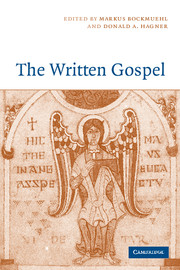Book contents
- Frontmatter
- Contents
- List of contributors
- List of abbreviations
- Introduction
- PART I BEFORE WRITING
- PART II WRITING THE FOUR GOSPELS
- 5 Who writes, why, and for whom?
- 6 How Matthew writes
- 7 How Mark writes
- 8 How Luke writes
- 9 How John writes
- 10 Beginnings and endings
- PART III AFTER WRITING
- Appendix: Graham Stanton's publications
- Bibliography
- Index of ancient sources
- Index of authors
10 - Beginnings and endings
Published online by Cambridge University Press: 07 December 2009
- Frontmatter
- Contents
- List of contributors
- List of abbreviations
- Introduction
- PART I BEFORE WRITING
- PART II WRITING THE FOUR GOSPELS
- 5 Who writes, why, and for whom?
- 6 How Matthew writes
- 7 How Mark writes
- 8 How Luke writes
- 9 How John writes
- 10 Beginnings and endings
- PART III AFTER WRITING
- Appendix: Graham Stanton's publications
- Bibliography
- Index of ancient sources
- Index of authors
Summary
Where the beginning is, there shall be the end.
(Gospel of Thomas, Logion 18)In recent years, New Testament scholars have become increasingly aware of the significance of beginnings and endings for their understanding of the Gospels. The beginning and ending of any literary composition are both important – not simply because the beginning provides a way of attracting the reader's attention, the ending a way of rounding things off – but because each provides important clues about the meaning of the material that lies in between. If these clues were, for many centuries, for the most part ignored, this was largely because the Gospels tended to be broken up into lectionary readings, rather than being read as wholes. Short passages read in this way make a very different impact from that which they have when read as part of a larger story: heard out of the context given them by the evangelist, they become once again independent pericopes, functioning as entities rather than as elements of something larger.
The Gospels are themselves part of something larger, however. Unlike the so-called ‘Gospel of Thomas’, which is a collection of sayings, our canonical Gospels are all narratives, and all narratives have to begin and end in particular places and at specific moments in time. Beginnings and endings provide ways of getting into and out of a sequence of events that begins long before and continues long after the story that is being told.
- Type
- Chapter
- Information
- The Written Gospel , pp. 184 - 202Publisher: Cambridge University PressPrint publication year: 2005
- 1
- Cited by



